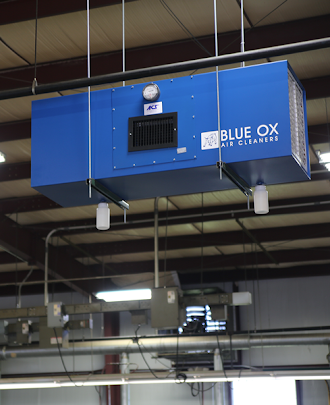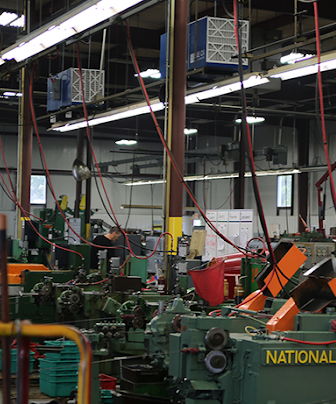
5 Key Questions for Choosing the Right Air Filtration System
Air filtration plays a crucial role in maintaining a safe and comfortable environment for machine operators, technicians, patients, and others nearby.
When air filtration is effective, it prevents contaminants from entering breathing zones and settling on work surfaces and floors, which can help reduce employee injuries and minimize production losses.
Air filtration systems are used in various industries to capture and filter hazardous fumes, smoke, gases, dust, and other pollutants.
These systems draw contaminated air through high-efficiency filters and create a circular airflow pattern, producing cleaner air. Not only do air filtration systems ensure cleaner air, but they also contribute to reduced energy consumption and maintenance costs.
Employers are responsible for the health and safety of their employees and customers. Air filtration systems help achieve clean, safe air, contributing to a comfortable and healthy environment.
When selecting an air filtration system, it's essential to choose the right model for your specific needs. To help with your decision, ask these five key questions.
1. What air filtration system is best for my application?
Choosing the right filtration solution depends on your specific needs. Whether you're operating a commercial or industrial facility, factors like the type of airborne contaminants (weld fumes, tobacco odors, VOCs, wood dust, etc.) and the preferred installation method will determine the most suitable system for your space.
Blue Ox air filtration systems are available in various configurations to meet the needs of most applications. Below are some of the filter technologies we offer. For further assistance, contact our team of specialists.
✓ Carbon Filter (CF) - For light odors. Refer to the Carbon Absorption Qualities Chart for information on charcoal's effectiveness in your application.
✓ Carbon Module (CC) - For applications with heavy odors. Check the Carbon Absorption Qualities Chart to see how carbon performs in your scenario.
✓ HEPA (HE) - For applications that require surgical-grade air.
✓ Wrap-Around Filter (WA/WAL/WAR) - Designed to extend pre-filter life in applications where large particulate or large amounts of particulate cause the pre-filter to face load quickly.
2. What's the CFM?
CFM is the amount of air that passes through an air filtration system at a certain point. To determine the required CFM, you'll need to calculate the size of your commercial or industrial workspace - multiply the length x the width x the height of the ceiling.
Installing the proper amount of air cleaners is key to meeting CFM requirements. In larger spaces, more air changes per hour are required.
3. Recommended air changes per hour?
Air changes make up the number of times the air in a workspace is pushed or pulled through an air pattern. Based on application requirements, there may be more or fewer air changes required.
Get in touch with our specialists to determine the recommended amount of air changes per hour for your application.
4. How to properly place air filtration systems?
Achieve maximum effectiveness with proper air cleaner placement! Air filtration systems work best in tandem and must be appropriately placed to develop a circular airflow pattern. Strategically placed air filtration systems will control odors and VOCs, prevent stale pockets of air, restrict bacteria, and more.
5. How many air filtration systems do I need?
Utilizing air filtration systems not only enhances the comfort and safety of machine operators, technicians, and other nearby employees but also helps lower maintenance and energy costs. Each air cleaning system uses a blower to "pull" contaminated air and capture harmful particulate through advanced filter media technology.
Air cleaning systems are most effective when used in tandem to develop circular airflow patterns. Air cleaning systems are made available in multiple configurations and styles but work similarly. With strategic air cleaner placement, you can remove odors and other VOCs, prevent stale air pockets, ward off pests, avoid bacteria, and restrict mold.
An air exchange is the number of times that plant air is pushed or pulled through a circular air pattern - you may require more or fewer air exchanges based on application demands. Installing the proper amount of air cleaners is key to meeting the CFM (cubic feet per minute) requirements - CFM requirements change based on the application and space.
Installing the appropriate amount of air filtration systems will guarantee that the CFM (cubic feet per minute) requirements are met. CFM requirements change based on the size of the workplace and the application.
To determine how many air filtration systems you need, you must first figure out the CFM.
Determine the correct CFM
To figure out the required CFM, you'll first need to calculate the size of your plant, facility, or workspace - multiply the length x the width x the height of the ceiling.
Use this calculation: L x W x H = Area of Grow Room
This example is based on Blue Ox air cleaning systems that exchange the air in a room 8 times per hour.
CFM = Area of Room (L x W x H) x Air Changes per Hour / 60 mins
Example: 40 X 30 X 30 = 36,000 Area of Room
36,000 Area x 8 Blue Ox air changes per hour = 288,000
288,000 / 60 minutes = 4800 CFM
If you require assistance with selecting the right air filtration system, reach out to our specialists. We're here to help with every step of the process.

✓ General - For dust or smoke applications without odors
✓ Carbon Filter (CF) - For general light odors. See the Carbon Absorption Qualities Chart for the effectiveness of charcoal in your application.
✓ Carbon Module (CC) - For applications that generate heavy odors. See the Carbon Absorption Qualities Chart for the effectiveness of carbon in your application.
✓ HEPA (HE) - For applications that require surgical-grade air.
✓ Wrap-Around Filter (WA/WAL/WAR) - Designed to extend pre-filter life in applications where large particulate or large amounts of particulate cause the pre-filter to face load quickly.
Blue Ox air filtration systems vary between 825 - 7,600 CFM. We provide air filtration solutions to commercial and industrial businesses of all sizes. For a recommendation based on the specific size of your workspace, get in touch with our team.
Our goal is to provide high-quality air filtration to help establish safe, regulation-compliant, and productive workplaces - regardless of industry.
You may also like:
• 5 Reasons You Need Air Filtration
• The Difference Between Air Filtration & Ventilation
• Everything You Need to Know About HEPA Air Filtration

Copyright © 2026 | Blue Ox Air Cleaners. A division of Air Cleaning Specialists, Inc.
